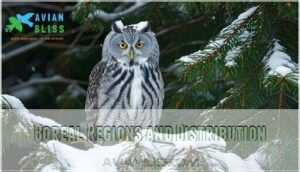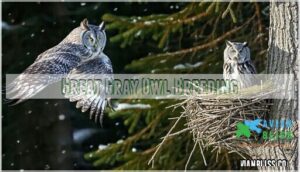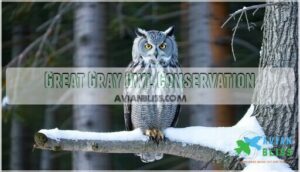This site is supported by our readers. We may earn a commission, at no cost to you, if you purchase through links.

Don’t let their imposing size fool you—they’re surprisingly lightweight at just 2-5 pounds, thanks to their incredibly fluffy feathers that trap air for insulation.
These "phantoms of the forest" inhabit dense boreal and montane forests across Canada, Alaska, and the northern United States.
Their distinctive features include piercing yellow eyes, prominent facial discs with concentric circles, and no ear tufts.
What makes them truly remarkable is their silent hunting ability—they can detect a mouse moving beneath two feet of snow from remarkable distances, making them nature’s most efficient winter predators.
Table Of Contents
- Key Takeaways
- Great Gray Owl Overview
- Great Gray Owl Habitat
- Great Gray Owl Behavior
- Great Gray Owl Breeding
- Great Gray Owl Conservation
- Frequently Asked Questions (FAQs)
- What is a great gray owl?
- Where can I find great grey owls?
- What is a great gray owl irruption?
- What states do great grey owls live in?
- Is it rare to see a great grey owl?
- Where can I see great grey owls?
- How long can great gray owls live in the wild?
- What are the main predators of great gray owls?
- How long do great gray owls live?
- What predators threaten great gray owls?
- Conclusion
Key Takeaways
- You’ll encounter North America’s longest owl species at up to 33 inches tall, but they’re surprisingly lightweight at just 2-5 pounds due to their fluffy insulation feathers that create a deceptively bulky appearance.
- You can identify them by their massive facial discs with concentric circles, piercing yellow eyes, and gray-mottled plumage without ear tufts—these features help them detect prey beneath two feet of snow.
- You’ll find these "phantoms of the forest" in dense coniferous forests adjacent to open meadows across Canada, Alaska, and northern U.S. states, where they hunt small mammals like voles with remarkable precision.
- You’re witnessing a species facing conservation challenges from habitat loss and climate change, despite their exceptional hunting abilities and the male’s dedicated provisioning during the 28-36 day incubation period.
Great Gray Owl Overview
When you encounter a Great Gray Owl in North America’s dense forests, you’re looking at the continent’s longest owl species, measuring up to 33 inches from head to tail.
Despite their impressive size and bulky appearance created by dense feather layers, these silent hunters weigh only two to four pounds—much less than you’d expect from such a formidable-looking bird.
Physical Characteristics
Standing tall as North America’s longest owl species, the great gray owl (Strix nebulosa) commands attention through its impressive physical presence.
You’ll notice this large owl’s distinctive plumage features gray, tan, and white mottling that creates perfect woodland camouflage.
The bird’s most striking characteristic is its enormous facial disk, framing piercing yellow eyes that seem to peer directly into your soul.
Despite appearing bulkier than great horned owls, feather density creates this illusion—most bulk comes from insulation rather than actual weight.
Identification Features
You’ll recognize a great gray owl by these distinctive identification features that set this large owl apart from other owl species.
You’ll spot this woodland phantom by its massive facial disk and piercing yellow eyes that seem to read your very soul.
The massive facial disk acts like a satellite dish, framing piercing yellow eyes that seem to stare right through you.
Here’s what to look for:
- Facial Disk – Enormous gray disc with dark concentric rings
- Plumage Details – Mottled gray, brown, and white feathering without ear tufts
- Eye Color – Bright yellow eyes with white patches between them
- Wing Shape – Broad wings with heron-like flight pattern
These features help distinguish Strix nebulosa from similar species despite size discrepancies in the field.
Size and Weight Comparison
You’ll find great gray owl size deceptive—it’s North America’s longest owl species, but weight tells a different story.
Despite reaching 84 cm in length, females average just 1,290 grams compared to great horned owls at 1,800 grams. This feather bulk creates an illusion.
Their large facial disc helps them hunt effectively. hunting skills are essential for their survival.
| Owl Species | Length (cm) | Weight (g) |
|---|---|---|
| Great Gray Owl | 61-84 | 580-1,900 |
| Great Horned Owl | 46-63 | 900-1,800 |
| Snowy Owl | 53-65 | 1,600-2,950 |
Great Gray Owl Habitat
You’ll discover Great Gray Owls in the dense coniferous forests that stretch across North America’s northern regions, where towering spruce and fir trees provide essential nesting and roosting sites.
These magnificent birds require a unique combination of thick forest cover for protection and adjacent open areas like meadows, bogs, and clearings where they can hunt their preferred prey of small rodents.
The combination of these habitats is crucial for the survival of these birds, allowing them to thrive in areas with dense coniferous forests.
Dense Conifer Forests
You’ll discover Great Gray Owls depend heavily on dense conifer forests for survival.
These boreal forest environments provide critical nesting sites, roosting protection, and forest dependence that shapes their entire lifecycle.
Forest management practices directly impact nesting density and prey abundance within their preferred owl habitat.
Climate impacts threaten these ecosystems, making owl conservation efforts focused on maintaining mature coniferous stands increasingly essential for Great Gray Owl populations, which rely on forest management practices.
Open Areas and Meadows
Three essential elements define prime Great Gray Owl hunting grounds: meadow size, prey abundance, and forest adjacency.
You’ll find these owls favor expansive meadows teeming with voles and rodents, positioned strategically next to dense conifer forests.
This habitat quality combination provides ideal hunting opportunities while maintaining proximity to essential roosting and nesting sites for survival.
Mixed forests offer specific habitats for different bird species, creating a unique environment that supports a variety of wildlife and avian life.
Boreal Regions and Distribution
You’ll encounter this phantom of the north across the vast boreal forests stretching from Alaska through Canada, with scattered populations extending into the northern Rockies.
This boreal species thrives where Northern Habitats provide the perfect balance of dense coniferous cover and open hunting grounds, adapting remarkably well to harsh climates across both North America and Eurasia.
- Range Expansion: Climate Adaptation allows populations to shift southward during severe winters when Prey Abundance decreases
- Habitat Requirements: Dense boreal forests adjacent to meadows, bogs, and clearings provide ideal hunting territories
- Forest Management: Sustainable logging practices that maintain forest openings benefit their range by creating ideal hunting conditions
Great Gray Owl Behavior
When you observe a Great Gray Owl in the wild, you’ll witness one of nature’s most skilled predators employing extraordinary hunting techniques that have evolved over millions of years.
These magnificent birds demonstrate complex behavioral patterns that include sophisticated hunting strategies, distinct vocalizations for communication, and remarkable dedication to their monogamous partnerships throughout the breeding season.
They also exhibit remarkable dedication to their specific habits, which is a crucial aspect of their survival and success in the wild.
Hunting Strategies
The Great Gray’s hunting prowess relies on exceptional auditory acuity, detecting prey beneath snow up to 45 centimeters deep.
You’ll witness silent flight adaptations that eliminate noise, preventing self-masking during prey detection.
These owls master snow plunging techniques, hovering before dropping face-first through crusted snow to capture voles and rodents below the surface with remarkable precision.
Their asymmetrical ear placement enhances sound localization.
Vocalizations and Communication
While hunting requires stealth, you’ll find Great Gray Owls aren’t entirely silent. Their vocal repertoire includes deep hoots, squeaks and wails that serve essential communication functions. Males produce booming territorial calls, while females emit higher-pitched courtship calls.
These vocalizations enable aggressive defense against intruders and facilitate owlet communication between parents and young. Key aspects of Great Gray Owl vocalizations are numerous and include various types of calls.
- Deep territorial hoots help establish and defend breeding territories
- Courtship calls strengthen pair bonds between mates during breeding season
- Begging calls from females signal food needs to hunting males
- Loud juvenile calls aid researchers in locating nests during surveys
- Individual call features allow scientists to identify specific owls with 97% accuracy
Monogamous Pairs and Nesting
During pair bonding, Great Gray Owls form monogamous relationships through mutual preening and courtship feeding rituals.
You’ll find these devoted partners selecting territory together, with males providing food while females handle egg laying duties.
For suitable habitats, consider providing an appropriate nesting structure.
Both parents exhibit fierce nest defense, aggressively protecting their forest habitat against intruders, including humans and bears, throughout the breeding season.
| Breeding Aspect | Details |
|---|---|
| Pair Bonding | Monogamous pairing through mutual preening and courtship feeding |
| Territory Selection | Dense conifer forests adjacent to open hunting areas |
| Nest Defense | Aggressive protection against all intruders, including large predators |
| Egg Laying | Female lays 2-5 white eggs in existing tree cavities or old hawk nests |
| Fledgling Care | Male feeds family for up to 3 months while female broods young |
Great Gray Owl Breeding
When you observe Great Gray Owls during breeding season, you’ll witness a remarkable partnership between mates that guarantees successful reproduction in harsh northern environments.
The female takes on incubation duties while the male becomes the primary provider, hunting tirelessly to feed both his mate and their future offspring, ensuring a successful reproduction.
Incubation and Fledging
When you discover a Great Gray Owl pair ready to breed, the female selects an old hawk or raven nest for her eggs.
She’ll lay two to five white eggs, then settle in for an incubation period lasting 28-36 days. During this time, she rarely leaves the nest, depending entirely on her mate for survival.
The owlets emerge as fluffy gray bundles, staying in the nest for three to four weeks before fledging. These young owls, called baby owls, are carnivorous from birth. However, their flight skills remain clumsy at first.
- Egg Laying: Females produce 2-5 pure white eggs in existing stick nests
- Incubation: 28-36 day period with female constantly brooding
- Fledging Time: Young owlets leave nest after 3-4 weeks but can’t fly well initially
Male Provisioning and Female Care
Once incubation begins, you’ll witness a remarkable division of labor between the sexes.
The male transforms into the family’s sole provider, undertaking relentless hunting expeditions while his mate remains devoted to nest duties.
| Male Hunting Behavior | Female Incubation Care |
|---|---|
| Hunts continuously for family | Maintains constant egg warmth |
| Delivers prey every 2-4 hours | Rarely leaves nest during incubation |
| Provides food for up to 3 months | Protects eggs from predators |
| Hunts day and night when needed | Regulates nest temperature precisely |
| Carries prey in talons to nest | Turns eggs regularly for development |
This parental role specialization guarantees chick fledging success.
The male’s food delivery system keeps the female nourished during her 28-36 day incubation period, while her dedicated brooding creates ideal conditions for embryo development.
Diet and Prey Preferences
Small mammals comprise 80-90% of their owl diet, with voles being the primary target.
You’ll find great gray owls have remarkable dietary adaptations, shifting from voles in boreal forests to pocket gophers out west.
Their snow plunging technique and exceptional prey detection abilities make rodent hunting incredibly effective, with hunting success rates enhanced by their ability to locate small mammals beneath deep snow cover.
Great Gray Owl Conservation
Despite their impressive size and adaptability, great gray owls face mounting conservation challenges that threaten their long-term survival across North America.
You’ll find these magnificent predators struggling against habitat loss, climate change, and human encroachment, making targeted conservation efforts more essential than ever.
Threats and Challenges
While successful breeding brings hope, Great Gray Owls face mounting challenges threatening their survival.
These silent giants encounter numerous obstacles across their range, making conservation efforts increasingly urgent.
The primary threats endangering these magnificent birds include:
- Habitat Loss – Logging removes nesting trees and destroys meadow foraging areas
- Climate Change – Shifting temperatures shrink boreal ranges and increase wildfire frequency
- Human Disturbance – Vehicle collisions during winter movements and illegal shooting
- Prey Scarcity – Rodenticide use reduces food sources, while drought affects rodent populations
Forest ecology disruption particularly impacts these specialized hunters, as they require specific combinations of dense forests and open meadows for survival.
Habitat Preservation and Management
Effective Forest Management requires balancing timber harvests with owl habitats, maintaining the dense coniferous forests and adjacent meadows these giants need.
You’ll find that Protected Areas alone aren’t enough—active Habitat Restoration and forest conservation strategies must address Climate Change impacts while ensuring Prey Abundance.
Strategic conservation planning connects fragmented landscapes, preventing habitat loss through thorough forest ecology approaches.
Planting native trees and shrubs can further enhance owl habitats.
Population Trends and Research Efforts
You’ll find that population estimates suggest around 95,000 Great Gray Owls globally, with Canada’s numbers doubling since 1970.
Monitoring programs face challenges tracking these elusive owl species, but conservation genetics research continues advancing our understanding.
Effective conservation strategies often rely on specialized tracking devices.
While habitat loss and climate impacts threaten local populations, collaborative efforts between wildlife agencies strengthen ornithology studies, helping protect this remarkable species through targeted ecology-based conservation strategies.
Frequently Asked Questions (FAQs)
What is a great gray owl?
You’ll recognize North America’s longest owl by its impressive 24-33 inch height, distinctive gray-mottled plumage, piercing yellow eyes, and remarkably large facial disk that helps detect prey beneath deep snow.
Where can I find great grey owls?
You’ll discover these magnificent owls in dense coniferous forests across northern regions, from Alaska through Canada to northern Minnesota, plus isolated mountain populations in Oregon, California, and Wyoming.
What is a great gray owl irruption?
When prey becomes scarce, you’ll witness northern populations moving south en masse—this dramatic southward migration is called an irruption, driven by food shortages in their boreal forest homes.
What states do great grey owls live in?
You’ll find great gray owls in Alaska, northern Minnesota, and scattered populations in western states including Montana, Idaho, Wyoming, Washington, Oregon, and California’s mountains.
Is it rare to see a great grey owl?
Despite their impressive size, you’ll likely never spot one roaming your neighborhood. Great gray owls are genuinely rare sightings outside their remote northern forest habitats, making encounters truly special moments.
Where can I see great grey owls?
You’ll find great gray owls in dense coniferous forests near open meadows, bogs, or clearings across Alaska, Canada, northern Rockies, and scattered mountain locations in Oregon, California, and Wyoming.
How long can great gray owls live in the wild?
Like ancient sentinels standing guard through countless seasons, these magnificent birds don’t reveal their lifespans easily in research.
You’ll find great gray owls typically live 7-13 years wild, though some exceptional individuals reach 15-18 years when conditions favor their survival, and they can be considered exceptional in this context.
What are the main predators of great gray owls?
You’ll face predators mainly when young or vulnerable.
Adult great gray owls rarely encounter threats due to their size, but martens, fishers, and goshawks can attack nestlings or fledglings in trees.
How long do great gray owls live?
Wild great gray owls typically live 7-9 years, though you’ll find some reaching 13 years in nature.
In captivity, they can live longer, with records showing lifespans extending into their late teens or early twenties.
What predators threaten great gray owls?
Remarkably, you’ll find that great gray owls face fewer natural predators than most owls due to their impressive size.
Great horned owls, northern goshawks, and occasionally ravens threaten eggs and young, while bears may raid nests, posing a threat to the owls.
Conclusion
Naturally, after millennia of evolution perfecting stealth technology, the great gray owl makes human attempts at silent movement look rather amateur.
You’ve discovered North America’s most formidable nocturnal hunter, whose remarkable adaptations enable survival in harsh northern climates.
Their exceptional hearing, silent flight, and impressive size make them apex predators of boreal ecosystems.
As climate change threatens their habitat, understanding these magnificent birds becomes essential for conservation efforts, ensuring future generations can witness these phantom hunters gliding through moonlit forests with unmatched grace.
- https://critterfacts.com/greatgrayowl/
- https://en.wikipedia.org/wiki/Eurasian_eagle-owl
- https://www.birdwatchersgeneralstore.com/what-is-the-biggest-owl/
- https://www.fs.usda.gov/r6/reo/survey-and-manage/downloads/great-gray-owl/mr-ca-bi-strix-nebulosa-2012-05.pdf
- https://www.owlresearchinstitute.org/copy-of-great-grey-owl











